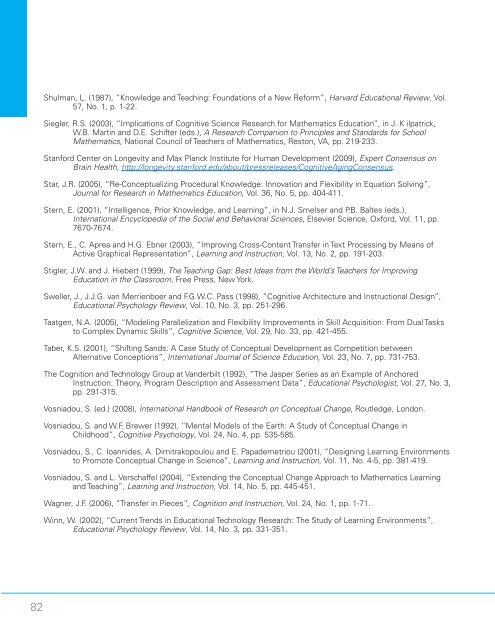del aprendizaje
2aGaJxc
2aGaJxc
Create successful ePaper yourself
Turn your PDF publications into a flip-book with our unique Google optimized e-Paper software.
Shulman, L. (1987), “Knowledge and Teaching: Foundations of a New Reform”, Harvard Educational Review, Vol.<br />
57, No. 1, p. 1-22.<br />
Siegler, R.S. (2003), “Implications of Cognitive Science Research for Mathematics Education”, in J. K ilpatrick,<br />
W.B. Martin and D.E. Schifter (eds.), A Research Companion to Principles and Standards for School<br />
Mathematics, National Council of Teachers of Mathematics, Reston, VA, pp. 219-233.<br />
Stanford Center on Longevity and Max Planck Institute for Human Development (2009), Expert Consensus on<br />
Brain Health, http://longevity.stanford.edu/about/pressreleases/CognitiveAgingConsensus.<br />
Star, J.R. (2005), “Re-Conceptualizing Procedural Knowledge: Innovation and Flexibility in Equation Solving”,<br />
Journal for Research in Mathematics Education, Vol. 36, No. 5, pp. 404-411.<br />
Stern, E. (2001), “Intelligence, Prior Knowledge, and Learning”, in N.J. Smelser and P.B. Baltes (eds.),<br />
International Encyclopedia of the Social and Behavioral Sciences, Elsevier Science, Oxford, Vol. 11, pp.<br />
7670-7674.<br />
Stern, E., C. Aprea and H.G. Ebner (2003), “Improving Cross-Content Transfer in Text Processing by Means of<br />
Active Graphical Representation”, Learning and Instruction, Vol. 13, No. 2, pp. 191-203.<br />
Stigler, J.W. and J. Hiebert (1999), The Teaching Gap: Best Ideas from the World’s Teachers for Improving<br />
Education in the Classroom, Free Press, New York.<br />
Sweller, J., J.J.G. van Merrienboer and F.G.W.C. Pass (1998), “Cognitive Architecture and Instructional Design”,<br />
Educational Psychology Review, Vol. 10, No. 3, pp. 251-296.<br />
Taatgen, N.A. (2005), “Mo<strong>del</strong>ing Parallelization and Flexibility Improvements in Skill Acquisition: From Dual Tasks<br />
to Complex Dynamic Skills”, Cognitive Science, Vol. 29, No. 33, pp. 421-455.<br />
Taber, K.S. (2001), “Shifting Sands: A Case Study of Conceptual Development as Competition between<br />
Alternative Conceptions”, International Journal of Science Education, Vol. 23, No. 7, pp. 731-753.<br />
The Cognition and Technology Group at Vanderbilt (1992), “The Jasper Series as an Example of Anchored<br />
Instruction: Theory, Program Description and Assessment Data”, Educational Psychologist, Vol. 27, No. 3,<br />
pp. 291-315.<br />
Vosniadou, S. (ed.) (2008), International Handbook of Research on Conceptual Change, Routledge, London.<br />
Vosniadou, S. and W.F. Brewer (1992), “Mental Mo<strong>del</strong>s of the Earth: A Study of Conceptual Change in<br />
Childhood”, Cognitive Psychology, Vol. 24, No. 4, pp. 535-585.<br />
Vosniadou, S., C. Ioannides, A. Dimitrakopoulou and E. Papademetriou (2001), “Designing Learning Environments<br />
to Promote Conceptual Change in Science”, Learning and Instruction, Vol. 11, No. 4-5, pp. 381-419.<br />
Vosniadou, S. and L. Verschaffel (2004), “Extending the Conceptual Change Approach to Mathematics Learning<br />
and Teaching”, Learning and Instruction, Vol. 14, No. 5, pp. 445-451.<br />
Wagner, J.F. (2006), “Transfer in Pieces”, Cognition and Instruction, Vol. 24, No. 1, pp. 1-71.<br />
Winn, W. (2002), “Current Trends in Educational Technology Research: The Study of Learning Environments”,<br />
Educational Psychology Review, Vol. 14, No. 3, pp. 331-351.<br />
82


